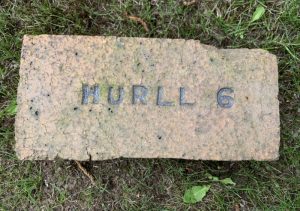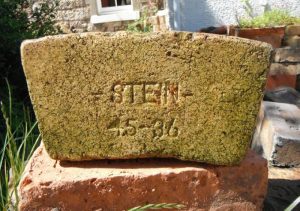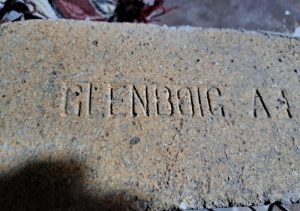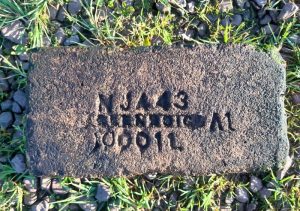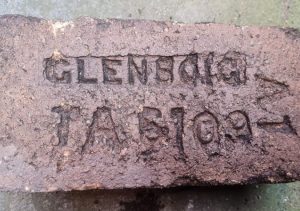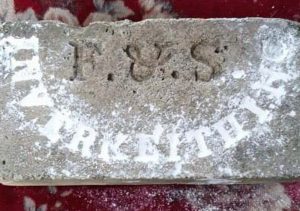Many thanks to Martyn Fretwell and David Cufley for their assistance with creating this page.
Many fire bricks are stamped BCM alongside the manufacturer’s name.
BCM – British Commercial Monomarks.
Below – 10/07/1925 – The Times – Indexing humanity. Men may soon be like motorcars. Lost property solution. Latest in classification. Modern life is to be simplified by a new system of individual and commercial identification which is the invention of an English businessman. Firms and people will be classified after the style of motorcars when the great idea is in force. Police authorities, the Post Office, and the Registrar-General at Somerset House all welcome the system, which in effect will give to every individual who pays a small fee a distinctive lettering and number. ‘Monomark’ is the name of the system and the company, which will operate in this country and in America. Monomark companies for the British Dominions and the Continental countries are in process of formation. The headquarters of the British concern will be Monomark House, in High Holborn. Mr William Morris, the inventor of the new index to humanity, explained all his theories at a public luncheon yesterday. He pointed out that there would be two kinds of monomarks, private and commercial. The private monomeric in England will be prefixed by the letters B.M. (British monomark), and the commercial by the letters B.C.M. (British commercial monomeric). The monomarks for other countries will vary in prefix—A for America. F for France, C for Canada and so on as the idea gains adherents throughout the world. “We give a B.M. monomark to the individual for 5s a year,” said Mr Morris “and the results are extraordinary. Instead of putting his initials on his luggage as he does at present, he will put his monomark. For example B.M/XOXI. The immediate result is that there need no longer be one million unclaimed articles per annum in lost property offices in London alone. He could engrave his monomark on his watch. A thousand-pound necklace might have a monomark as small as a hallmark engraved upon the clasp. Tiny metal labels could be attached to almost any personal belongings. A bicycle might be monomarked. Bunches of keys of course could be monomarked. One would scribble ones monomark on a parcel one is carrying, and in fact, the personal belongings of all the members of one family can be protected at a cost of 5s a year. In all cases of lost and mislaid articles, the finder should write to the monomark on the article. The company will not itself handle lost goods. Its duty finishes when it puts the loser in touch with the finder and vice versa. It will be of great service to all authorities in the country and to insurance offices. It is anticipated that the immense congestion of lost and mislaid articles will at once be relieved. The monomark will not only be a clue but the equivalent to a name and address. Consider the use of monomarks when used as laundry marks. At present, every laundry you may be a customer of marks your linen with its own particular number that it gives you. A monomark being readily indexable and having no duplicate should be acceptable by every laundry. Many a woman receives from the cleaners a fur, a pair of curtains or whatnot and maintains that it is not the article she sent. The monomark overcomes this difficulty much to the relief of both the cleaner and his customer. A child becoming lost or a relative meeting with an accident would be readily identified by the monomark on the linen or belongings.”
One of the chief arguments for the monomeric endorsed by Sir Sydney Skinner, head of Messrs. John Barker and Co., who presided at the luncheon, is the advantage it will give to British trade abroad. A commercial monomeric on goods would be a complete identification to the firm of origin. “I do not think that trade at the present time is anything like so bad as some people try to make out,” said Sir Sydney Skinner. “There are brains in the trade of this country which will make success in spite of handicaps. The monomark system will be of immense help in furthering the trade of Britain.”
23/09/1925 – Aberdeen Press and Journal. A colossal A.B.C. of Trade Marks, the first of its kind to be compiled in this country, has just been completed by the skeleton staff of the Monomark Company. Although purely pictorial designs have been ignored, and the matter restricted to combinations of letters and numerals, more than 120,000 registrations have been recorded. Each entry contains the following information: Trademark; Name of the firm; Class in which registered; Year of registration; Number of the trademark (as published in the official journal); Products for which registered. In describing the great amount of work entailed by this compilation, an official of the Monomark Company stated that 50 specially qualified girls had been employed on this job for more than a year. By permission of the Registrar, the work was carried out first at the Trade Mark Office in Chancery Lane and subsequently completed at the company’s headquarters. Such an up-to-date record forms an essential part of the equipment required for the monomark. Although this scheme has not yet been officially launched, applications are already pouring in to the company; and, in order to avoid possible infringement of registered trademarks, each combination, of letters or figures for which the application is made must be indisputably checked. Without this register, it would be impossible for the official Monomark House, to check applications, except by reference to the indexes at the Patent Office London, where trademarks are classified and filed according to trades. Each article for which a trademark has been registered is classified under one of fifty headings, and the search for any particular trademark is not exhausted until all the 50 classes have been examined. The new register compiled for use at Monomark House will enable the existence or non-existence of a trademark to be verified by reference to one alphabetical list instead of 50 classes and the checking can thus be carried out within a few seconds.
Below – 06/11/1925 – The Scotsman.



11/11/1925 – Nottingham Journal – The new system of monomarks. Its value in trade and private life. British Monomarks. Ltd., are putting before, the manufacturers in this country an ingenious scheme for bringing them an increasing number of customers. The idea is that all subscribers will be allotted a monomark, that is a few letters, in reality, a hallmark, which, stamped on his goods, will advertise him all over the world. There will be no duplicates, for the Company hold the copyright 24,000,000 marks. To give an example of the working, a trader in Canada sees an article stamped, say, “S & Co.” He desires to stock it but does not know where to apply. Under the new system, it will be stamped say “BCM/HLS” which means that if the Canadian addresses an inquiry to “BCM/HLS, London W.C.1” by arrangement with the Post Office the letter is delivered to British Monomarks Ltd who forward it to the manufacturer. There need be no fear that the Canadian, the African, the American businessman will not know of the system for the company have arranged an intensive publicity campaign all over the world. The full value of monomarks can hardly be explained in a short newspaper article but a postcard addressed to 19 Abingdon Street, Westminster, London S.W.1 will bring a very informative booklet. It may, however, be pointed out the Monomark can be used as a cable address, for “key” purposes, which will reveal that goods so stamped are made in England and the forger of such goods, would be detected as letters of inquiry would reach the original firm. Apart from its commercial advantages, the Monomark can be of service to the individual; it is a short officially recognised address, it will recover lost property, motor cars, and so forth; on clothes, it will put hospital authorities in touch with relatives and enable the police to restore lost children. There is in brief, no end to the ways in which the monomarks may be of public and private service.
Below – 17/09/1926 – Northampton Chronicle and Echo.

Below – 30/01/1930 – Clifton and Redland Free Press.

25/09/1930 – The Scotsman – The fifth ordinary general meeting of British Monomarks (Ltd), which had been adjourned from August 1929, was held yesterday in London, and was followed by the sixth ordinary general meeting of the Company. Mr William T. Morris, the chairman, reminded the shareholders that at the meeting in August last year a resolution was passed that the report and accounts for 1928 be not adopted, and the meeting was adjourned sine die. A committee was appointed and the Board had adopted the resolution of the committee. The report and accounts for the year 1928 were then adopted. The sixth ordinary general meeting was then held. The Chairman in moving the adoption of the report and accounts for 1929 said that the Company had successfully weathered the adverse effects of the late Board’s proposal to liquidate the Company. The commercial monomark was the mainstay of the Company’s activities, and during the year from 14,000,000 to 15,000,000 pairs of British boots were manufactured bearing the maker’s monomark, and more than 500,000,000 roofing tiles during 1929 were indelibly stamped with the maker’s monomark. As to the personal monomark no fewer than 2,000,000 letters had been delivered with the monomark only as the address, whilst the Company’s operations continued to work smoothly with the Post Office. The liquid resources of the Company, which amounted to £13,779, had been carefully husbanded. The loss for the year of £6,390, compared with a loss of £16,074 for 1928, showing an improvement of £10,000 on the year and he anticipated a further improvement in the current twelve months.
1931 – A list of distinctive marks, trade names and trademarks appearing on bricks, tiles, stone and sanitary ware. (Note – SBH – It is surprising none of the Scottish fireclay makers that used the monomark ‘BCM’ are on this list but perhaps they simply did not start using the system until after 1931).


Below – 1937 – Architects Compendium – Bricks with registered British Commercial Monomarks. (Many thanks to Paul and Cynthia for unearthing this advert).

1956 – Modern Brickmaking 4th edition by Alfred B. Searle. Page 37 – Marks on bricks – A monomark is a registered code of letters and numbers which, by arrangement with the Post Office, can be used as an address for letters if the word ‘London’ is added. Hence the manufacturer of a monomarked brick can be communicated with by letter.
2022 – The company still exists.
Below – Scottish bricks stamped BCM
Below – 3 x examples of John Gilchrist Stein manufactured bricks. ‘Thistle’ was a trademark of Steins.
- Stein, Castlecary Fireclay Works, Castlecary, Stirlingshire.
- Stein, Manuel Firebrick and Refractory Works, Whitecross, Stirlingshire.
- Stein & Co, Anchor Brickworks, Denny, Stirlingshire.
- Milnquarter Fireclay & Gannister Works, Bonnybridge, Stirlingshire.

.

.

Below – BCM Castlecary – Castlecary Fireclay & Lime Works, Castlecary, Stirlingshire.

Below – 4 x examples of BCM Hurll bricks. PMH = Peter and Mark Hurll and ‘Klinit’ is a Hurll trademark.
Garnqueen Fireclay Works, Glenboig, Lanarkshire
Alternative brickworks include:
- Gartliston Fireclay Works, Glenboig, Lanarkshire.

.

.

.

Below – 2 x BCM Heathfield bricks. Heathfield Fireclay Works, Garnkirk, Lanarkshire.

.

Below – Glascot is a mystery name but perhaps it is related to the BCM monomark in that it represents Glasgow Scotland. This brick is very likely linked in manufacture with the Sankey Scotch bricks depicted below.

Below – Some possible examples of the B.M. monomark use on bricks. See this link for an explanation of the Sankey and Scotch relationship. Click me.
(Note – SBH – I am not sure why BCM was not used as a monomark instead of BM as the bricks are surely a commercial situation rather than a private enterprise).

.

.

.

Below – These are 2 English examples. BCM Coronet and BCM Heather.

.

Below – This BCM/ACME roof tile was found by Ian Suddaby at Macmerry, East Lothian. This would appear to be a product of the Acme Tileries – G. H. Downing Ltd had 6 tileries in the North Staffordshire area in the 1930s.

Below – 10/03/1930 – Sheffield Daily Telegraph – Magnesia BCM GX. (GX = Genefax) Found by Ian Suddaby at the site of the old Ravenscraig Steelworks, Motherwell, North Lanarkshire.

.

Below – 05/06/2022 – This wonderful advert was forwarded by Martyn Fretwell. He had received it from Jim Gifford, marketing director at British Monomarks. Unfortunately, it is undated. BCM Jacobean, Sankey, Thistle, S102, GRC Magnesite, Hurll P&H, Castlecary and Glenboig ( Note – SBH – No known example of a BCM Glenboig brick has been found as yet).

*****************
(Note – SBH – Below is my original research and I have added it here for interest’s sake and just in case there is another twist in the tail!).
BCM stands for the British Ceramic Manufacturers (Federation) which was formed from the British Pottery Manufacturers Federation at some point between 1954 and 1995.
The BPM was formed in 1919.
After 1995 it was the British Ceramic Confederation.
The B.C.M.F. is the body that represents all the major United Kingdom manufacturers in the ceramics industry, including tableware, tiles and electrical insulators. as well as sanitaryware.
There is however apparently a list of BCMs in the 1931 Directory of Clayworkers directory which infers a formation date of the BCM of 1931 or before.
(Note – SBH – There is confusion as to whether BCM stands for British Ceramic Manufacturers or British Clay Manufacturers. It may be that one morphed into the other at some point).































